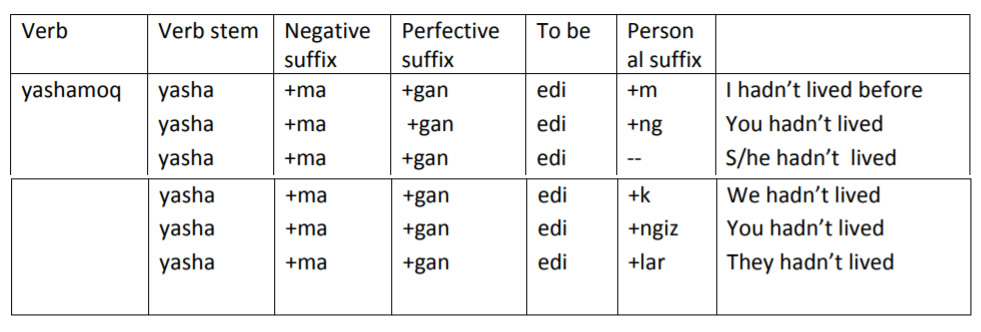Difference between revisions of "Language/Northern-uzbek/Grammar/Past-Perfect-Tense"
m (Quick edit) |
m (Quick edit) |
||
| Line 1: | Line 1: | ||
[[File:Uzbek-Language-PolyglotClub.png|thumb]] | [[File:Uzbek-Language-PolyglotClub.png|thumb]] | ||
<div | <div class="pg_page_title"> Past Perfect Tense (Tugallangan o’tgan zamon). </div> | ||
This form is used when talking about completed action in a distant past, before the recent action took place. It is formed by adding edi – use to (that is the past participle), plus the possessive type of personal suffixes. The associated words with that tense are before – avval, oldin, ilgari. | This form is used when talking about completed action in a distant past, before the recent action took place. It is formed by adding edi – use to (that is the past participle), plus the possessive type of personal suffixes. The associated words with that tense are before – avval, oldin, ilgari. | ||
[[File:Uzbek-Past-Perfect-Tense-PolyglotClub.jpg]] | [[File:Uzbek-Past-Perfect-Tense-PolyglotClub.jpg]] | ||
For example: | For example: | ||
*Men Fargo’onada bedana palovini yegan edim. Men Toshkentdan avval Gulistonda yashagan edim. | *Men Fargo’onada bedana palovini yegan edim. Men Toshkentdan avval Gulistonda yashagan edim. | ||
The negative is formed by adding to the verb stem the suffix -MA, plus the suffix -GAN, followed by the past ending edi plus the personal suffix | The negative is formed by adding to the verb stem the suffix -MA, plus the suffix -GAN, followed by the past ending edi plus the personal suffix | ||
[[File:Uzbek-Past-Perfect-Tense-Negation-PolyglotClub.jpg]] | [[File:Uzbek-Past-Perfect-Tense-Negation-PolyglotClub.jpg]] | ||
The negative may also be formed using the verb stem plus the suffix -GAN, followed by the negative copula emas, followed itself by the past copula edi plus the personal suffix. | The negative may also be formed using the verb stem plus the suffix -GAN, followed by the negative copula emas, followed itself by the past copula edi plus the personal suffix. | ||
| Line 33: | Line 22: | ||
*kelgan emas edilar / edi They hadn't come | *kelgan emas edilar / edi They hadn't come | ||
<span link>Don't hesitate to look into these other pages after completing this lesson:</span> [[Language/Northern-uzbek/Grammar/Pronouns|Pronouns]], [[Language/Northern-uzbek/Grammar/Future-Tense|Future Tense]], [[Language/Northern-uzbek/Grammar/Orthographic-rules|Orthographic rules]] & [[Language/Northern-uzbek/Grammar/Conditional-Mood|Conditional Mood]]. | |||
==Sources== | ==Sources== | ||
https://slaviccenters.duke.edu/sites/slaviccenters.duke.edu/files/file-attachments/uzbek.original.pdf | https://slaviccenters.duke.edu/sites/slaviccenters.duke.edu/files/file-attachments/uzbek.original.pdf | ||
== | ==Other Lessons== | ||
* [[Language/Northern-uzbek/Grammar/Present-Continuous-Tense|Present Continuous Tense]] | * [[Language/Northern-uzbek/Grammar/Present-Continuous-Tense|Present Continuous Tense]] | ||
* [[Language/Northern-uzbek/Grammar/Negation|Negation]] | * [[Language/Northern-uzbek/Grammar/Negation|Negation]] | ||
| Line 49: | Line 37: | ||
* [[Language/Northern-uzbek/Grammar/Future-Tense|Future Tense]] | * [[Language/Northern-uzbek/Grammar/Future-Tense|Future Tense]] | ||
* [[Language/Northern-uzbek/Grammar/Comparative-Adjectives|Comparative Adjectives]] | * [[Language/Northern-uzbek/Grammar/Comparative-Adjectives|Comparative Adjectives]] | ||
<span links></span> | |||
Latest revision as of 13:06, 27 March 2023
This form is used when talking about completed action in a distant past, before the recent action took place. It is formed by adding edi – use to (that is the past participle), plus the possessive type of personal suffixes. The associated words with that tense are before – avval, oldin, ilgari.
For example:
- Men Fargo’onada bedana palovini yegan edim. Men Toshkentdan avval Gulistonda yashagan edim.
The negative is formed by adding to the verb stem the suffix -MA, plus the suffix -GAN, followed by the past ending edi plus the personal suffix
The negative may also be formed using the verb stem plus the suffix -GAN, followed by the negative copula emas, followed itself by the past copula edi plus the personal suffix.
- kelgan emas edim I hadn't come
- kelgan emas eding You hadn't come
- kelgan emas edi He/she/it hadn't come
- kelgan emas edik We hadn't come
- kelgan emas edingiz You hadn't come
- kelgan emas edilar / edi They hadn't come
Don't hesitate to look into these other pages after completing this lesson: Pronouns, Future Tense, Orthographic rules & Conditional Mood.
Sources[edit | edit source]
Other Lessons[edit | edit source]
- Present Continuous Tense
- Negation
- The verb KELMOQ – to come
- Compound verb
- Adjectives
- Postpositions
- Expressing a desire fo an action
- Formal and informal YOU
- Future Tense
- Comparative Adjectives


